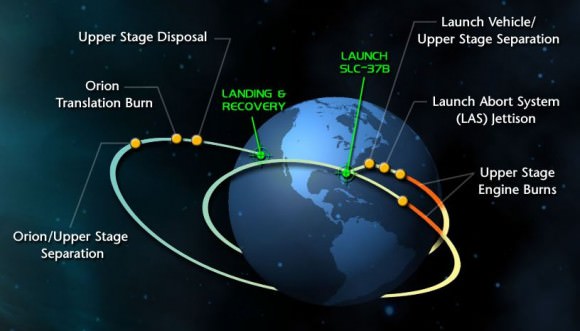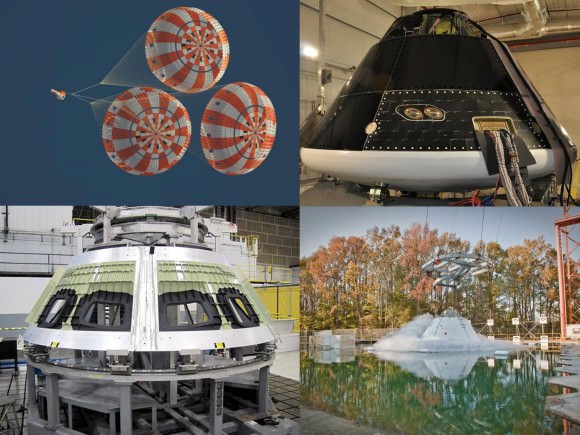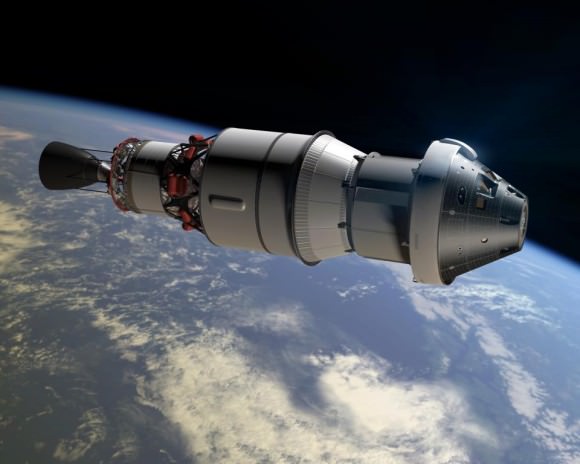[/caption]
CAPE CANAVERAL, Fla – NASA has announced its intention to launch an unmanned flight of the Orion Spacecraft atop a United Launch Alliance (ULA) Delta IV Heavy launch vehicle – by 2014. This flight test will be added to the contract that the space agency has with aerospace firm Lockheed Martin. The Orion Multi-Purpose Crew Vehicle or Orion MPCV as it is more commonly known – will test out systems that will be employed on the Space Launch System (SLS). If successful, this will allow astronauts to travel beyond low-Earth-orbit (LEO) for the first time in over four decades.
“This flight test will provide invaluable data to support the deep space exploration missions this nation is embarking upon,” said NASA Associate Administrator for Communications David Weaver.
The flight has been dubbed Exploration Flight Test or EFT-1 and will be comprised of two high-apogee orbits that will conclude with a high-energy reentry into the Earth’s atmosphere. Like the Mercury, Gemini and Apollo capsules before it, the Orion MPCV will conduct a water landing.
The test mission will lift off from Cape Canaveral Air Force Station located in Florida. It is designed to provide the space agency with vital flight data regarding how the vehicle handles re-entry and other performance issues.

“The entry part of the test will produce data needed to develop a spacecraft capable of surviving speeds greater than 20,000 mph and safely return astronauts from beyond Earth orbit,” said Associate Administrator for Human Exploration and Operations William
Gerstenmaier. “This test is very important to the detailed design process in terms of the data we expect to receive.”
Presumably the use of a Delta IV Heavy would allow NASA to accelerate its human exploration objectives at an accelerated rate. Since the flight will be unmanned, there is no need to man-rate the launch vehicle and given the current economic issues facing the United States, the use of so-called “legacy” hardware could ensure that costs are kept down.

NASA has also stated its intention to release competitive solicitations for design proposals for new, advanced liquid or solid boosters to be used on the SLS. Another contract that will be opened for competition will be for payload adaptors for both crewed as well as cargo missions.
The Orion spacecraft was originally part of the Constellation Program. Its design has since been modified – but its mission to one day fly astronauts to the Moon, Mars and beyond – remains. The EFT-1 test flight will allow technicians and NASA officials to better determine what further changes need to be made to best aid the completion of NASA’s exploration goals.



I thought “Orion” was a designation reserved for a (to date hypothetical) spacecraft propelled by a series of nuclear bombs — see Niven/Pournelle’s _Footfall_ and Poul Anderson’s _Orion Shall Rise_.
[grumbles about kids today having no sense of history]
I like the multi and multi positionable drag chutes. It would be good to see something flying that isn’t the end of something but a positive way to start to look forward again!
Is NASA now talking return to the moon, or are we just speculating on a post obama future? I like the Lunar route, but was surprised to see it mentioned twice in this article.
“Its design has since been modified – but its mission to one day fly astronauts to the Moon, Mars and beyond – remains.” and,
“The EFT-1 test flight could pave the way for flights back to the Moon, to the planet Mars and to other destinations throughout the solar system. Image Credit: NASA.gov”
Just wondering.
The Moon is, AFAIU, in the program.
The Augustine report that lead to the cancellation of the previous costly Constellation program suggested the Flexible Path (FP), which allows for the Moon. US politics doesn’t allow for tax increases, seems like, so I don’t think you can put it on the administration that the available resources are shy of what FP needed in the original timeline.
Obama himself has repeatedly supported Moon and FP type strategies, both during campaigning (“endorses the goal of sending human missions to the Moon by 2020”) and at office (“a set of crewed flights will test and prove the systems required for exploration beyond low Earth orbit”).
Also, the NASA Authorization Act of 2010 of US Congress has kept FP with lunar missions: “The extension of the human presence from low-Earth orbit to other regions of space beyond low-Earth orbit will enable missions to the surface of the Moon and missions to deep space destinations such as near-Earth asteroids and Mars.”
I don’t see why we would go to the Moon “en route” to asteroids or Mars, it is a waste of resources for that. But there are scientific reasons to explore it (Earth-Moon system history) and commercial reasons to exploit it (tourism). So I expect it will happen with a combo of unmanned and manned flights.
Can someone please tell me what NASA is doing about the radiation problem? Packing in a bunch of astronauts and shooting em off toward an asteroid without properly identifying a way to protect them during the journey hardly seems wise.
I read somewhere that they intend to use water and polyethylene, but water is only stored in the service module.
Maybe a good idea for a mission would be to go to high earth orbit, outside the van allen belts of course, somewhere possibly half or a third of the way to the moon. The astronauts can do a 6 month stint there to test out radiation shielding technologies. The longest any astronaut has stayed outside Earth’s protective magnetic field is on the order of days, not even weeks. It just seems hasty to have an asteroid (or any deep-space) mission without learning what it’s like to live in deep-space.
This seems to be unaddressed. It would take a decent CME event to turn this space capsule into a coffin. This program, as well as the Space-X system, is maybe alright for being a delivery system, but a spacecraft which goes to Mars or ventures to asteroids would have be comparable to the space station, and would need radiation protection for astronauts. Charged particle radiation from the sun is very lethal, and a CME event could kill an unprotected crew in a matter of days.
LC
The first rule of space club is, don’t die in space club. Yes, it seems prudent to research that.
I don’t know about the lethality here. If they are really harmful I see from a mentioned statistics that they are frequent during busy years: ~ 300 Earth-directed halo CMEs 1997-2003, or ~ 1 each week. Presumably then they can’t be that bad, or the Apollo missions wouldn’t have made it.
I found this [referring to a giant sunspot flare]:
“On the Moon, Cucinotta estimates, an astronaut protected by no more than a space suit would have absorbed about 50 rem of ionizing radiation. That’s enough to cause radiation sickness. “But it would not have been fatal,” he adds.
To die, you’d need to absorb, suddenly, 300 rem or more.
The key word is suddenly. You can get 300 rem spread out over a number of days or weeks with little effect. Spreading the dose gives the body time to repair and replace its own damaged cells. But if that 300 rem comes all at once … “we estimate that 50% of people exposed would die within 60 days without medical care,” says Cucinotta.
Such doses from a solar flare are possible. To wit: the legendary solar storm of August 1972.
It’s legendary (at NASA) because it happened during the Apollo program when astronauts were going back and forth to the Moon regularly. At the time, the crew of Apollo 16 had just returned to Earth in April while the crew of Apollo 17 was preparing for a moon-landing in December. Luckily, everyone was safely on Earth when the sun went haywire.
“A large sunspot appeared on August 2, 1972, and for the next 10 days it erupted again and again,” recalls Hathaway. The spate of explosions caused, “a proton storm much worse than the one we’ve just experienced,” adds Cucinotta. Researchers have been studying it ever since.
Cucinotta estimates that a moonwalker caught in the August 1972 storm might have absorbed 400 rem. Deadly? “Not necessarily,” he says. A quick trip back to Earth for medical care could have saved the hypothetical astronaut’s life.
Surely, though, no astronaut is going to walk around on the Moon when there’s a giant sunspot threatening to explode. “They’re going to stay inside their spaceship (or habitat),” says Cucinotta. An Apollo command module with its aluminum hull would have attenuated the 1972 storm from 400 rem to less than 35 rem at the astronaut’s blood-forming organs. That’s the difference between needing a bone marrow transplant â?? or just a headache pill.
Modern spaceships are even safer. “We measure the shielding of our ships in units of areal density–or grams per centimeter-squared,” says Cucinotta. Big numbers, which represent thick hulls, are better:
The hull of an Apollo command module rated 7 to 8 g/cm2.
A modern space shuttle has 10 to 11 g/cm2.
The hull of the ISS, in its most heavily shielded areas, has 15 g/cm2.
Future moonbases will have storm shelters made of polyethelene and aluminum possibly exceeding 20 g/cm2.
A typical space suit, meanwhile, has only 0.25 g/cm2, offering little protection. “That’s why you want to be indoors when the proton storm hits,” says Cucinotta.”
I think, the moon travelers were just lucky. I don’t know, and don’t want to look it up right now, they may have been on their way during a solar minimum. The the chances of CMEs are much lower. A decent CME might have caused the death of all three astronauts, but AFAIK there were none.
Here, I’ve saved you the bother: Sickening Solar Flares.
If Cucinotta is correct, those that there on the surface would have been rushed to a hospital alive if they could launch being that sick (perhaps not likely), those on the CM would survive “easily” (but again, problems with navigation). I don’t know if anyone has survived 400 rem.
It would have been bad, anyway.
The Moon would be much safer given that you have tonnes of regolith to surround yourself with, and sky-holes and craters and whatnot. Plus you have only half the exposure as you have the actual Moon underneath you.
Deep-space is the bigger issue here as you are not only completely exposed from all sides, but there’s no place to hide from the big daddy of CEMs. Unless there’s some strong-walled chamber, but this spacecraft doesn’t seem big enough I don’t know..
I suppose you could say that they would be doing their missions when activity is low in the solar cycle but that’s barely an excuse for a long-term space program.
Agreed. I think you are assuming forewarning on the Moon/asteroids (which btw make a good shield). There are, I think (haven’t checked), such systems that cover the cis-lunar space at least.
I like the idea of using a thick coating of Ice XI sprayed/frozen around a shielded habitat or ‘safe house’/vault. Ice XI is ferro electric which raises the possibility of using it to create a lattice of structural shapes, which are then charged to induce the desired shape magnetic field about the habitat….. Graphene anodes anyone? Just prior to arrival at the destination the ices are melted and redistributed for further use.
The ISS is a perfect lab for mag. field generation experimentation in low gravity conditions and it’s use as such should be at the very TOP of the research agenda! That and the VASIMR prog..
Is it me, or is that movie rather pitiful? (It is likeliest weekend blues, but that is precisely why I need other’s opinion.)
Cheer up, Torbjörn; you know what they say…
Thanks, it’s me then. Good, I wouldn’t want NASA to loose their cheerful outlook!
It is nice to have test flights but it seams an awful lot of money for not much in the way of progress.
First MPCV is not large enough for long term long range missions without a habitation module so apart from a solo maned flyby of the moon MPCV can not do anything more than could be done with Dragon. Dragon has flown into space and returned safely already and could use its LEO launch vehicle to do an elliptical orbit and re-entry any time it is funded.
The Delta 4 is not man rated or planed to be man rated so there is no benefit from using this rocket especially as you would get change from 2 Falcon Heavy launches for the same price. The Falcon Heavy is designed to be man rated and additional test flights would help this process.
Comparison Orion so far $5 billion NASA money for launch escape test and parachute test, no orbital test and no launch vehicle. Dragon so far total spend from SpaceX and NASA combined $800 million Launch vehicle 2 test flights capsule one test flight, Heavy Launch vehicle in development with main core 2 flights and Final configuration test flight scheduled 2013. Which is better value?